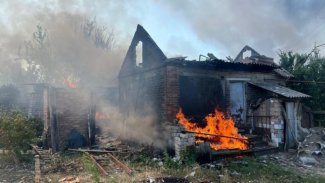The Russian army breaks through north of Pokrovsk. Day 1266 of the war

![]()
In the Pokrovsk area, Russian forces have made significant gains, breaking through the Ukrainian defensive line to the northeast of the Pokrovsk–Myrnohrad agglomeration. They have driven a wedge northwards, reaching the outskirts of the village of Hruzke. In just three days, Russian troops have advanced nearly 10 kilometres, seizing the settlements of Kucheriv Yar and Zolotyi Kolodiaz, located east of Dobropillia, a key town for Ukrainian logistics. The direct threat to the town has increased after Russian forces continued their offensive, taking control of Nove Shakhove, Vilne, Rubizhne and Bilychke. According to some reports, Russian sabotage and reconnaissance units are now operating on the outskirts of Dobropillia.
This sudden advance is the result of Russia’s concentration of a large force in this sector. On 9 August, the spokesman for the ‘Dnipro’ Operational-Strategic Group of Forces reported that 100,000 Russian troops were operating in the area. They have employed a tactic of persistently harassing the defending units with assaults by small combat groups, numbering only a few soldiers each, with the aim of identifying weak points in the defence and creating a breach. This manoeuvre has succeeded due to personnel shortages in Ukrainian defensive positions. As a result, the defence of Pokrovsk has become even more difficult; Russian forces are also moving closer to encircling Kostiantynivka from the west.
Russian forces have also made gains in the Lyman sector, taking control of the eastern part of the former Serebryansky forest reserve and preparing to cross the Chornyi Zherebets river. Capturing the settlement of Zarichne would facilitate the encirclement of Yampil from the north and bring Russian forces close enough to Lyman from the east to constantly harass the town with drones.
Russian units have also pressed on with efforts to expand their gains north of Kupiansk, widening their salient towards the villages of Holubivka and Radkivka. Making further advances and capturing Myrove (known as Moskovka until June this year) and Sobolivka would allow them to sever the route from Kupiansk to Chuhuiv, significantly disrupting Ukrainian logistics.
Ukrainian forces have managed to stabilise the situation to some extent in the Sumy sector. They have retaken Bezsalivka and expelled Russian troops from Stepne and Novokostiantynivka.
![]()
Russia has continued its large-scale missile and drone strikes to destroy civilian infrastructure. In recent days, Zaporizhzhia has become a target of these attacks. On 6 August, aerial bombs hit a holiday resort, killing two people and injuring several others, including children. On 10 August, dozens of Shahed kamikaze drones struck residential buildings, a bus station and a medical clinic, injuring at least 23 people. On the same day, the Crisis Centre of the Zaporizhzhia Nuclear Power Plant, located in the city, was also damaged.
On 6 August, Shahed drones also targeted Nikopol, killing three people and injuring six. The city was struck again on 10 August, leaving 12 people wounded. On 7 August, Russian drones attacked Kharkiv, damaging industrial facilities; on 8 August, they hit Bucha, destroying dozens of private buildings, a kindergarten and a church; on 9 August, they struck industrial plants in Dnipro; and on 10 August, they targeted the oblast administration building in Sumy – the second such strike in two weeks.
During the night of 6–7 August, Russian drones attacked a gas pumping station in Orlivka in Odesa Oblast, near the Ukrainian–Romanian border. This facility has been used to import gas via the Trans-Balkan pipeline from Azerbaijan. On 28 July, the gas companies of both countries, Naftohaz and SOCAR, signed an agreement for a test delivery of gas. In the night of 8 August, Russian Shahed drones struck a fuel depot in Odesa Oblast belonging to the Azerbaijani company. Presidents Volodymyr Zelensky and Ilham Aliyev discussed these attacks in a phone call, describing them as deliberate Russian actions aimed at obstructing the transport of Azerbaijani gas to Ukraine and other European countries. On 11 August, the Azerbaijani government announced it had provided Ukraine with $2 million in humanitarian aid for the purchase of electrical equipment.
During the night of 11–12 August, Russian forces carried out a missile strike on a training base, killing one soldier and injuring 11 others. Meanwhile, The New York Times reported on 12 August that a Russian strike on a military training centre in Kropyvnytskyi on 21 July had killed at least 12 foreign volunteers and wounded more than 100 other members of the International Legion.
![]()
Over the past week, units of Ukraine’s military intelligence and the Unmanned Systems Forces have carried out a large-scale attack on fuel infrastructure in Russia, forcing at least one Russian refinery to halt operations. On 7 August, Ukrainian drones hit the Afipsky refinery in Krasnodar Krai, causing a fire that, according to local authorities, was quickly extinguished. On 10 August, Ukrainian kamikaze drones struck a refinery in Saratov, inflicting damage that likely forced the facility to suspend operations. On the same day, an explosion occurred following a drone attack on an oil processing facility in Ukhta, in the Komi Republic, around 1,700 kilometres from the Ukrainian border. On the night of 11–12 August, drones struck facilities at the Monocrystal plant in Stavropol, which manufactures optoelectronic equipment for military use; the extent of any damage remains unknown.
On 11 August, Ukraine’s military intelligence (HUR) carried out a successful cyberattack against the infrastructure of Filanco, one of Russia’s largest internet and hosting service providers for the country’s security sector. The operation destroyed 11 servers and erased around 17 terabytes of data. Approximately $1.3 million were also stolen from the company’s accounts.
![]()
On 5 August, Denmark, Norway and Sweden announced they would fund a US-supplied package of ammunition, mainly for Patriot systems, and military equipment worth a total of $500 million. Sweden pledged $275 million, Norway – $135 million and Denmark – $90 million. It was also announced that the new assistance mechanism for Ukraine, under which European countries will purchase weapons and military equipment in the United States, operates under the name Prioritised Ukraine Requirements List (PURL).
On the same day, the US State Department issued two export approvals for Ukraine worth a combined $203.5 million, covering spare parts and repair and maintenance services for M777 155mm towed howitzers ($104 million) as well as transportation services for the delivery of weapons, military equipment and other related logistics ($99.5 million).
On 6 August, in an interview with the Frankfurter Allgemeine Zeitung, Major General Maik Keller, deputy commander of NATO’s Security Assistance and Training for Ukraine (NSATU) initiative, confirmed that several months ago Russian forces had seriously damaged one of the German-supplied Patriot batteries. The fire-control radar required repairs in Germany, which were successfully completed, and the battery returned to the battlefront in July. Therefore, publicly available information indicates that Russian forces have successfully struck at least two of the five Patriot batteries supplied to Ukraine, putting them temporarily out of action.
![]()
Since the start of this year, almost 30,000 Ukrainian soldiers who had left their units without permission have returned to service in the Armed Forces. As the State Bureau of Investigation stressed on 5 August, this solution offers a chance for those who have committed desertion to return to the military without facing criminal liability – provided that a court issues such a ruling.
On 6 August, Defence Minister Denys Shmyhal announced that the government had endorsed a draft law aimed at strengthening protections for whistleblowers – soldiers reporting cases of corruption within the defence structures. The legislation enshrines the right to report suspected corruption to authorities including the National Agency on Corruption Prevention (NACP) and removes the requirement to inform a direct commander about such cases.
On the same day, Ukraine’s ambassador to Poland, Vasyl Bodnar, stated that the fifth group of volunteers from the Ukrainian Legion in Poland would sign contracts with the Armed Forces of Ukraine at the recruitment centre in Lublin. He noted that the facility enables Ukrainians abroad to undergo initial training, return to their homeland and join the military in an orderly and safe manner. Poland provides equipment, weapons and training infrastructure, while Ukraine supplies the volunteers with uniforms and medical gear. The government in Kyiv has not disclosed the number of contracts signed.
On 7 August, the non-governmental Anti-Corruption Centre revealed that the Defence Procurement Agency (DPA) had delivered only 23% of the drones contracted in 2025 to the Armed Forces. DPA is the military’s largest drone buyer; this year, it has signed agreements worth 102 billion hryvnias (c. $2.5 billion). A day earlier, the State Audit Office launched an inspection of drone procurement covering the entire process, from planning and contracting to monitoring execution. The audit is expected to identify irregularities in this area and propose corrective measures.
![]()
On 5 August, the Head of the Office of the President of Ukraine, Andriy Yermak, reported that components manufactured by Indian companies Vishay Intertechnology and Aura Semiconductor had been found in downed Russian Shahed-136 attack drones. He stressed the need to prevent Russia from obtaining foreign dual-use goods and noted that Ukraine had formally raised this issue in talks with the Indian government and the EU.
On the same day, the Commander-in-Chief of the Armed Forces of Ukraine, General Oleksandr Syrskyi, stated that given Russia’s plans to form 10 new divisions by the end of this year, two of which have already been established, Ukraine has no choice but to continue mobilisation, expand combat training and strengthen the military’s unmanned systems component. He estimated Russian losses in July at over 33,200 personnel, 800 more than in the previous month, adding that the Russian military is increasing its numbers by around 9,000 soldiers a month.
On 11 August, Ukraine’s State Border Guard Service reported the arrival of several hundred Russian troops and the deployment of dozens of pieces of military equipment in Belarus. The soldiers are expected to take part in the joint Russian-Belarusian military exercise Zapad 2025, scheduled for September. At the same time, some Belarusian forces have been sent to Russia, which will host exercises as well. Ukraine’s border guard emphasised that it continues to monitor the situation closely, particularly for signs of further Russian troop transfers to Belarus and any potential threat to Ukraine. It assessed that the current Russian troop presence in Belarus does not pose a serious threat, but did not rule out the risk of provocations or an escalation in the border area during the drills.
![]()
On 7 August, the website of the so-called Ministry of Education and Science of the Luhansk People’s Republic published a list of Ukrainian children from Luhansk Oblast, including detailed descriptions of their character, interests and even physical appearance. The data can be ‘filtered’ by gender, eye colour and hair colour, resembling a slave catalogue, where children are described as ‘calm’, ‘obedient’ or ‘easy to get along with’. Most of the children held Ukrainian citizenship before the Russian occupation. Some lost their parents as a result of the war, while others were forcibly issued Russian documents to legalise their abduction. According to a team of experts from Yale University, around 35,000 Ukrainian children listed as missing may be residing in Russia or in the occupied territories. Some have been forcibly adopted, placed in orphanages or sent to military facilities.






